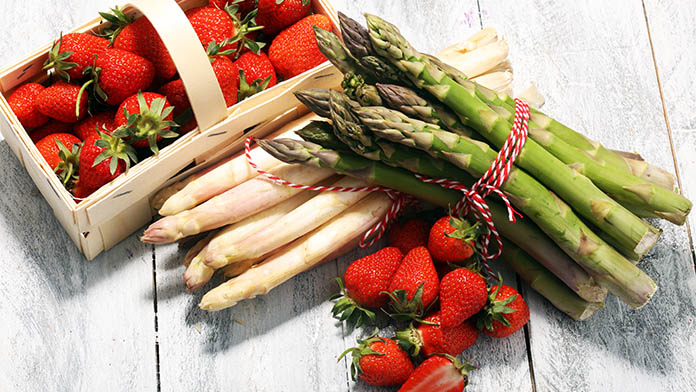Why is it so important to consume seasonal fruit and vegetables? Because it means fully enjoying their nutrients, ingesting fewer pesticides and saving money. Pay attention to it: in the summer, when it’s hot and we sweat, there are watermelons and melons, rich in water and beta-carotene, which protect skin exposed to the aggressions of the sun’s rays. In winter, on the other hand, citrus fruits rich in vitamin C, such as oranges, are depopulated, which enhance the immune system. In short, it is nature that provides us with the most suitable nutrients, at the right time.
Food of the month maggiowhich are juicy, fresh and full of water, are important for our body because they help us to eliminate toxins accumulated during the wintera fight water retention it’s at get a good dose of vitamin C for the warmer months.
May fruits and vegetables: strawberries
Strawberries play an important role in our nutrition because they are 90% made up of water: this is why they hydrate the body without weighing it down with too many calories. I am rich in enzymes capable of activating fat metabolism, helping the body to lose weight with less effort. They contain the fibre, which increase the sense of satiety, regularize the intestine and absorb less fat and less sugar. There vitamin C it promotes the absorption of iron, useful for the formation of red blood cells and for muscles, and the production of collagen, a protein that prevents wrinkles and strengthens the capillaries, reducing water retention and cellulite.
This anti-retention action is enhanced by the potassium (they contain 160 mg per 100 g of edible portion), a mineral of which strawberries are very rich. They have also been included among the superfoods that “keep you young” in the special ORAC (Oxygen Radical Absorbance Capacity) classification drawn up by the USDA (the US Department of Agriculture), for the record content of antioxidant substances health benefits.
Loquats
The medlars, with an intense yellow-orange colour, are very rich in vitamin A (170 µg per 100 g of edible portion), soccer, carbohydrates e potassium (250 mg per 100 g of edible portion). If consumed unripe, they have astringent properties; if eaten very ripe, they have a laxative effect.
Cherries
The cherries begin to ripen towards the end of the month and are available until July. Always recommended for those suffering from inflammation of the joints, contain vitamin A and vitamin C. Like all red fruits they are rich in anthocyanidinswater-soluble molecules of the flavonoid family which are antioxidants and protect against free radicals responsible for premature aging of cells.
Rich in potassium (229 mg per 100 g of edible portion), they quench thirst in the hottest season and have diuretic properties. Warning: consumed in large quantities they can have a laxative effect.
May fruits and vegetables: peas
Peas are a concentrate of vitamin B1 and vitamin A, contain very large quantities of potassium (193 mg per 100 g of edible portion), of phosphorus, sodium, magnesium e ferroof which the pods that can be used to prepare soups are also rich. They can be eaten as a side dish or to flavor first courses, they give a sense of satiety and purify our body.
Fave
The fave are the typical legumes of this month. They not only contain Vitamin B, fibre e ferro but they are above all rich in potassium (200 mg per 100 g of edible portion) and of of phosphorus (93mg). They are excellent for purifying the body and are low in calories. Attention: not everyone can eat broad beans. Those affected by favism risk severe anaphylactic shock.
May fruit and vegetables: asparagus
The asparagus they are rich in fibre, vitamine (E, C, B e A) e folic acidessential when you are pregnant. There are also mineral salts, among which of phosphorus, soccer and the chromecapable of improving insulin production and lowering blood glucose levels when high.
The most important nutrient contained in this food is the glutathione, which is the most powerful of the antioxidants produced by the body. It fights aging through two main ways: the intestine and the circulatory system. It protects the cells, tissues and organs of the body managing to keep it young. L’inulin, which is a soluble fiber, makes them natural anti-inflammatories. The only embarrassing “defect” is that cause foul-smelling urineperhaps due to asparagusic acid.
Food composition data source: CREA
